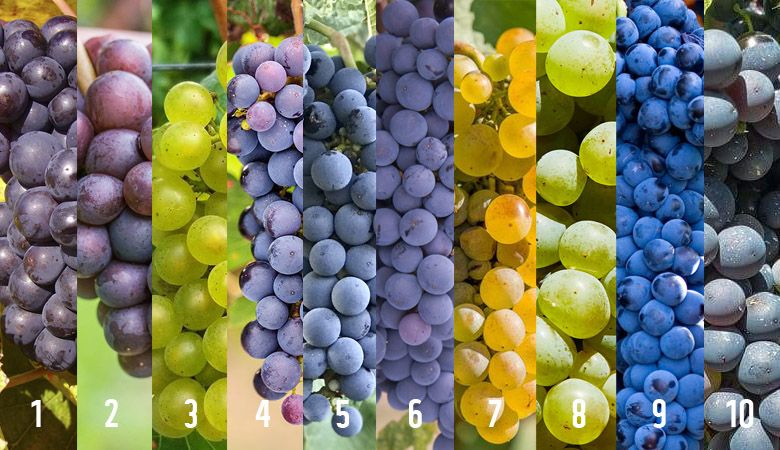Oregon Grapes at a Glance
Winemakers talk shop on top
Oregon’s top 10 varieties present a deep, sophisticated line-up. To properly explore these grapes, it would take a book to cover all the nuances, wineries and personalities who make each one a success here in Oregon. Instead, OWP presents the top varieties from the words of the winemakers themselves. The ranking is based on annual planted acreage and production data posted by the Oregon Wine Board in the 2019 Oregon Vineyard and Winery Report. The Board will post its 2020 edition online in August.
1. Pinot Noir
22,016 annual planted acres;
61,112 production tons
For Ken Wright of Ken Wright Cellars (Yamhill-Carlton/Willamette Valley), it’s what happens underground, where root meets rock, that truly distinguishes this variety. “What makes Pinot Noir by far the best wine of them all is its ability to connect us to place,” he explains. “Most other varieties have traits that follow the wine wherever it goes. Pinot Noir is the opposite. It’s incredibly transparent. The uptake of trace elements when the roots finally reach the mother rock about 20 feet under the soil gives tremendous complexity to the wine.”
Why buyers like it: “Terrific for food pairings,” Wright says. “For example, a lot of wines obliterate salmon. But with Pinot, the wine and salmon make each better. They elevate each other.”
Winemaker recommends: Ken Wright Cellars 2018 Savoya Vineyard Pinot Noir
2. Pinot Gris
5,200 annual planted acres;
15,694 production tons
When Ed King of King Estate Winery (Willamette Valley) sits down to a meal of crab cakes, chicken or lobster, he says, “I want a wine that’s crisp and lean. No heavy-handed oak, no musky, earthy or mineral flavors to struggle through.” His choice: Pinot Gris, a variety his family’s winery started championing in 1992; currently, it counts for two-thirds of King Estate’s wine production. King enjoys it for being a simple yet zesty taste experience. “It goes with everything,” he says.
Why buyers like it: “It exhibits freshness, a quality that makes it well-suited to the American palate,” King suggests. “People like fresh food, and they want fresh wine to go with it.”
Winemaker recommends: King Estate 2019 Steiner Block Pinot Gris
3. Chardonnay
2,568 annual planted acres;
6,780 production tons
“Chardonnay is a chameleon grape. It can be grown in many places and will easily take on characteristics of that place,” explains Luisa Ponzi, director of winemaking and viticulture for Ponzi Vineyards (Laurelwood District/Willamette Valley), now owned by the Bollinger Family.
“Where it most highly performs and truly shows the beauty of the variety itself is in cool-climate regions like Oregon. This is where the floral, spice and stone-fruit aromas shine. The palate can be finessed and elegant, bright with minerality, salinity and acidity. Winemaking style can push the wines toward textured and silky or focused and linear but always fresh and beautiful.”
Why buyers like it: “Customers who, for the most part, are accustomed to domestic Chardonnay made from warmer climates, are blown away by Oregon Chardonnays.” Ponzi says. “It’s a wine easy to love, but also can be profound and complex. It loves foods on a wide spectrum of fresh and bright, to rich and buttery. An aged Oregon Chardonnay with a creamy pungent cheese at the end of a meal is the absolute best.”
Winemaker recommends: Ponzi Vineyards 2017 Chardonnay Reserve
4. Syrah
1,621 annual planted acres;
4,735 production tons
“Syrah, in my experience, likes to be quite dramatic. It flops about everywhere and is extremely suggestive to the direction of the wind,” says Brooks Delmas Robertson, director of winegrowing for Delmas/SJR Vineyard (The Rocks District of Milton-Freewater/Walla Walla Valley). “Head-training these vines helps the theatrical nature of Syrah and the deep volcanic gravel depositions provide a global distinctiveness.”
Why buyers like it: “Syrah, like Pinot, offers a real sense of place on the palate,” Robertson explains. “The fine loam between the basalt cobbles offers a more elegant texture and complex aromatics. These soils help elevate the silky tannin, and savory and saline qualities enhance any meal.”
Winemaker recommends: Delmas 2018 SJR Vineyard Syrah
5. Cabernet Sauvignon
1,410 annual planted acres;
3,102 production tons
Winemaker Jean-Michel Jussiaume of Del Rio Vineyard Estate (Rogue Valley) notes how Cabernet Sauvignon “performs specifically well in Southern Oregon with its strong diurnal variation and a long, dry growing season. Those magnify the aromatics and contribute to a rich, silky tannin and great structure.”
Why buyers like it: “It’s a wine that pairs well with the uniquely American cuisine, especially grilled meat,” Jussiaume explains.
Winemaker recommends: Del Rio 2018 Anniversary Cabernet Sauvignon
6. Merlot
736 annual planted acres;
2,128 production tons
Winemaker Bobby Richards of Seven Hills Winery (Walla Walla Valley), who recently took over winemaking operations from Seven Hills founder Casey McClellan, continues the latter’s commitment to world-class Merlot. “Merlot has nice red fruit flavors and good body,” said Richards. “But it’s not so assertive as the Cabs. It’s lusher.”
Why buyers like it: “People find this to be a good entry wine, not too tannic, but well-balanced and elegant,” Richards says.
Winemaker recommends: Seven Hills 2018 Founding Vineyard Merlot
7. Riesling
435 annual planted acres:
1,541 production tons
James Frey of Trisaetum Winery (Ribbon Ridge/Willamette Valley) bottles nine different Rieslings and six of those are single-vineyard versions. “Much like Pinot Noir, Riesling does this remarkable job of taking what’s in the soil and putting it in the glass. From my experience, few white grapes do a better job at highlighting the place in which it’s planted,” he explains. “Since we have wonderful soil diversity here, a Riesling from Dundee is very different than a Riesling from Ribbon Ridge, even though they’re planted only a few miles apart.”
Why buyers like it: “Customers love Riesling because it’s effusively aromatic, mouthwateringly racy and, in the right vintage, can be a rather thought-provoking wine,” Frey notes. “It’s also one of those rare white wines that gets better with time in the cellar.”
Winemaker recommends: Trisaetum 2019 Ribbon Ridge Dry Riesling
8. Viognier
368 annual planted acres;
1,145 production tons
“Unlike the rich, heavy California versions, the Applegate Valley produces a very unique style of Viognier,” explains Craig Camp of Troon Vineyard. “The Viognier here combines crisp acidity and minerality with exotic spiciness.”
Why buyers like it: “Its lush, floral character is very attractive,” Camp says. “It’s well-balanced and refreshing to drink.”
Winemaker recommends: Troon 2020 Kubli Bench Amber (an orange wine blend starring Viognier)
9. Cabernet Franc
357 annual planted acres;
801 production tons
“I love this wine for its complexity and how it consistently ripens in our climate,” explains Brian Gruber of Barrel 42 Custom Winecraft and Quady North (Applegate Valley/Rogue Valley). “When planted in the right sites, the wine shows ripe tannins, complex notes of red pepper and earth, plus bright acidity.” Gruber says Cab Franc is also versatile enough to be made into excellent white, rosé and even sparkling.
Why buyers like it: “Cabernet Franc is outstanding at expressing varietal purity, and it’s terrific with food,” Gruber says. “It has bright acidity, fruit, earth and peppery spices.”
Winemaker recommends: Quady North 2015 Cabernet Franc
10. Tempranillo
352 annual planted acres;
1,200 production tons
Inspired by Earl Jones of Abacela, Rachael Martin of Red Lily Vineyards (Applegate Valley/Rogue Valley) added Tempranillo to her repertoire. “Tempranillo has taught me about patience. The variety demands it,” she says. “I learned early on about tannin management when it came to this grape. Extracting the fine-grained tannins and leaving the harsh ones behind can feel like walking a tight rope. I love working with something so complex and powerful that holds so much finesse and has the ability to express itself in different ways.”
Why buyers like it: “It holds so much appeal and layers of concentrated flavors,” Martin says. From cigar box notes to saddle leather, brambles and spice. It’s explosive on the palate and pairs great with hearty dishes.”
Winemaker recommends: Red Lily 2015 Life of Riley Red Blend (78% Tempranillo and 22% Cab Sauv)
The Jones Factor
Using a scientific approach, Earl and Hilda Jones of Abacela Winery searched for the ideal location and climate to plant America’s first Tempranillo. He found it in the Umpqua Valley. His next contribution? Albariño. Other successful varieties under his care include Cabernet Franc, Malbec, Grenache, Sangiovese and Port-style Douro varieties Tannat, Tinta Amarela, Touriga Nacional and Graciano.
The Joneses made their first Tempranillo wine in 1997. The next vintage, 1998, became the first American Tempranillo to best the Spanish in a global judging, earning a double-gold medal at the San Francisco International Wine Competition; the wine defeated 19 Spanish masters at their own game.
Growers and winemakers, taking note of Abacela’s achievements and scientific methodology, have followed suit by also championing these once-unusual varieties.











